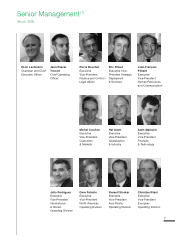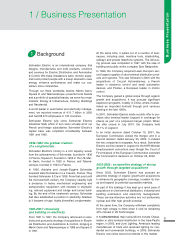APC 2005 Annual Report Download - page 19
Download and view the complete annual report
Please find page 19 of the 2005 APC annual report below. You can navigate through the pages in the report by either clicking on the pages listed below, or by using the keyword search tool below to find specific information within the annual report.
17
Global, selective purchasing
Our purchases total around 40% of Group sales and
represent a major reservoir of potential savings. To
make the most of this potential, we intend to globalize
75% of our purchases and increase local sourcing in
emerging markets. We use raw materials such as sil-
ver, copper, aluminum, steel, non-ferrous metals and
plastics, as well as electronic components to manu-
facture our products. Our supplier list includes interna-
tional companies such as Nippon Steel, DSM and
Arcelor, as well as many medium-sized firms like Gin-
dre Duchavany or AMI Doduco.
Suppliers are selected for their know-how, their prod-
uct quality and competitiveness and their compliance
with environmental and social responsibility require-
ments. We support the United Nations’ Global Com-
pact and encourage our suppliers to join as well. A
sustainable development agreement sets out each
party’s specific commitments.
Worldwide redeployment of
production and supply chain resources
Schneider Electric has more than 200 production
sites, of which 45% manufacture for the global market.
The other units are located as close as possible to
their end markets. Although design or aesthetic fea-
tures may be adapted to meet local requirements, we
standardize key components as much as possible to
generate scale economies during production. This
global/local approach helps us optimize profitability.
Drawing on our global scope, we intend to build last-
ing competitive advantage to support long-term, prof-
itable growth. More than 700 projects have been initi-
ated around the world to re-balance and capitalize on
our manufacturing and supply chain resources. Our
objectives are to:
Produce as close to customers as possible to
improve service quality and our ability to respond
quickly.
Achieve a lasting balance between production costs
and revenue within each currency zone to limit the
impact of foreign exchange fluctuations.
Produce and source in the most competitive region
for a given product.This means low-wage countries for
products with a high labor content, for example, and
developed countries for complex, highly automated
processes and services that require a strong local
presence.
In Western Europe and the United States, rightsizing
plans have been deployed with a focus on specializing
units, reducing their number and increasing their size.
At the same time, we have moved manufacturing clos-
er to demand by increasing capacity in Eastern
Europe, Mexico, India, China and the rest of Asia.
Lastly, we are improving productivity by extending the
application of our Six Sigma, Lean Manufacturing and
Quality and Value Analysis programs. Their global
deployment and sharing of best practices should allow
all our plants to achieve the same level of operating
performance.
A major IT systems project
On November 2, 2004, Schneider Electric signed a
ten-year services contract with Capgemini that was
extended to twelve years in an amendment signed on
March 10, 2006. The contract covers on the one hand
outsourcing of all the Company’s IT departments and
functions in Europe and on the other hand the design,
development and construction of a global core system
called "Bridge", as well as its deployment in Europe.
The IT departments of some 100 European sub-
sidiaries in 31 countries were outsourced in 2005.
Around 800 employees were transferred to Capgemi-
ni, along with IT assets such as licenses and service
contracts related to the outsourced departments.
The Bridge project is designed to deploy an SAP-
based global ERP core system across the Group. The
project’s vision and detailed design phases were final-
ized in July 2005. Core system construction is current-
ly under way, with pilot site deployment scheduled for
2007-2008. Full-scale deployment should begin in
2008, at the end of the pilot phase, and cover a peri-
od of four years.
The outsourcing program in Europe and the Bridge
project are intended to make Schneider Electric more
efficient and reduce overall IT costs. In light of their
complex nature and geographic and functional scope,
the Group has set up a dedicated governance and
cost-control structure to manage the challenges
involved and limit related risks.
Human resources
Creating a stimulating working environment is our
human resources strategy’s chief objective. Specific
policies have been developed, covering international
mobility, career development, training, compensation
and diversity. These general guidelines are applied
through local programs.
Developing skills and embracing diversity
Schneider Electric is a global Company with a diverse
geographic, market and customer base. This diversity
is reflected and encouraged in our workforce.
To support growth and prepare the future, we develop
and promote multi-cultural teams with managers from
different countries who are able to take on major
responsibilities in a decentralized organization. This
policy helps us attract, retain and develop the best
people in all of our host countries.
We encourage geographic mobility and nurture inter-
national leadership. This is one of the goals of our
Marco Polo international hiring program, which gives
high potential graduates the opportunity to work for
two years in another culture before returning home.
Business Presentation
8
























